Rock Island Armory M206 Parkerized Finish or Matte Nickel Review
Brothers:
I'm presenting this mail service, not to state an alternative (unfortunately) for the Indian firearms market, but to testify what ought to be possible. The subject of this post is the Armscor 38 Special revolver that is available in the U.s.a., marketed by Rock Island Arsenal. This revolver, like other Armscor firearms, is made in the Philippines -- hardly a nation known for a robust industrial base. The underlying point to my post is that surely Republic of india could do but every bit well, if not meliorate, than the Philippines in this area of manufacture and marketing.
Armscor makes revolvers in 38 Special, 357 Magnum, 9mm, and 22. They also have a line of semi-automobile pistols, including a 1911 model, and long guns, likewise. For this post, I want to comment on their 38/357 line of revolvers, because I would similar to have one myself. Please annotation the list price of these firearms. The 38 Special iv" barrel revolver I'd like has a list toll of $249 (₹18502 at today's exchange rate) and they are listed at the local gun store for $229.99 -- simply ₹17090 -- today.
Here is the manufacturer's website link to the revolver: https://www.armscor.com/firearms-list/m200-38spl-6rd
These guns are not perfectly finished at this price point, only past all reviews, they are quite serviceable as purchased over the counter. Hither is a review from the "American Rifleman" mag of the snub olfactory organ version of this revolver. There are other reviews of these guns online, but in this dismal world of fanboy advertising cloaked equally a magazine review, this one independent the best analysis that I could find:
(As always, click on the pictures for a larger view!)
Review: Rock Island Arsenal M206 Revolver
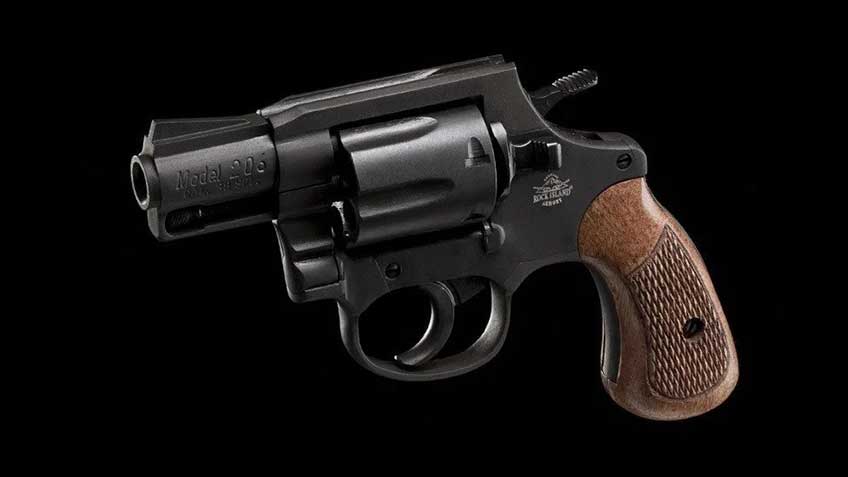
I'm a fan of hard-working .38-cal. revolvers for personal protection. They're reliable, simple to operate and pack a solid level of stopping power when loaded properly. But non everyone who wants a defensive revolver can shell out the kind of greenbacks needed for some models.
Hoping to find a solution to this problem, I've spent the last few years looking around various trade shows in search of a useful and affordable new .38 Special or .357 Magnum. I wanted something that could be put to work as a truck gun, a kit gun or fill the important roles of dwelling defence force or concealed carry for those who are financially strapped.
For the most office, the fruits of this quest have been disappointing. When looking at new revolvers with prices under $400, some of what you'll find is downright spooky. Poor craftsmanship, mysterious and unidentifiable alloys, and triggers that feel like dragging a chunk of physical across a sheet of sand newspaper grow.
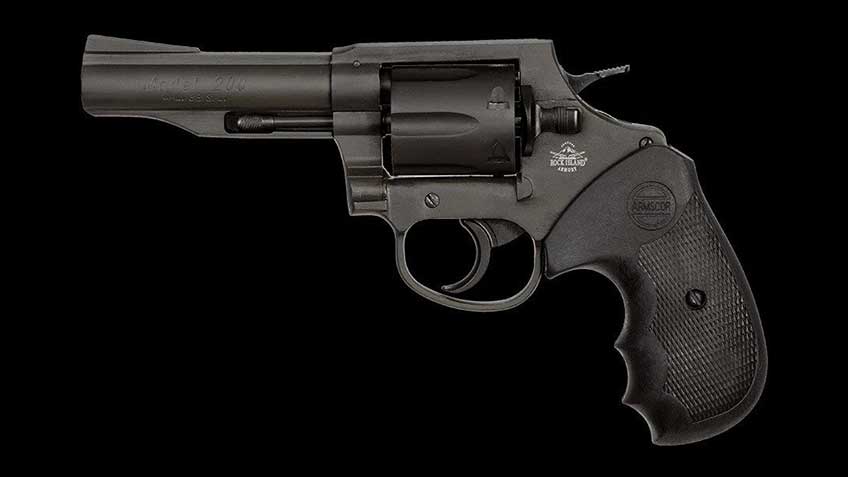
The original M200 revolver in the RIA lineup features a 4" butt and polymer grips.I had nigh given upwardly on finding an inexpensive revolver worth testing when I stopped by the Armscor USA and Rock Island Armory berth at SHOT Show a few years back. Information technology had slipped my mind that Stone Island's catalog of firearms fabricated in the Philippines contains a couple of revolver models including the 4" butt M200 and the two" barrel M206.
I noticed the six-shot .38s this time around because the company had ii on brandish front and center. The representative explained that in add-on to the standard Parkerized double-action M206 model, the company was adding spurless double-activeness-merely versions that year in both a Parkerized and satin nickel end.
Let me be articulate with revolver fans who have an heart for aesthetics: the M206 is not going to win any beauty contests. It is a uncomplicated, all-steel revolver that sacrifices outward refinements for costs savings. The Parkerized and nickel finishes were properly applied if not necessarily attractive. Opening the cylinder revealed casting and grinder marks that 1 would not see on more expensive .38s.

The configuration of the M206 shows a mix of influences. The frame, six-shot cylinder, pull-back cylinder release and old-fashioned checkered wood grip are all reminiscent of the Filly Detective Special. The single-piece 2.15" barrel, which is pinned to the frame, has a fixed forepart sight and squared off ejector shroud seemingly borrowed from Charter Arms.
The low-mounted, spade-shaped hammer spur of the double-activeness model is unlike any other modern hammer that I've worked with and so far. The securely curved, polish-faced trigger is housed in a rounded trigger guard. A transfer-bar safety prevents the revolver from firing if bumped or dropped.
I'll freely admit here that my previous experiences with budget-friendly wheelguns accept left me feeling a bit jaded. The looks of the M206 revolvers lying there on the table did not exactly cause my heart to race. But my impression of the revolvers changed in one case I started handling them.
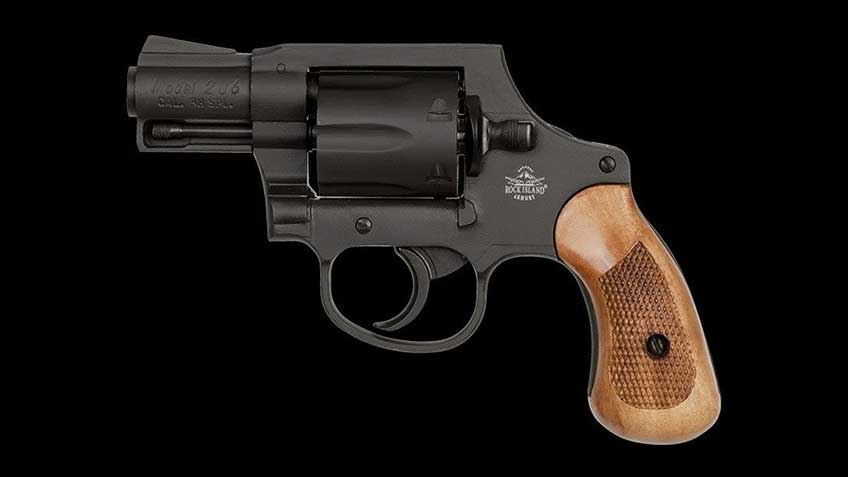
The problems institute in some inexpensive imports were absent in the M206. In that location was no grit in the cylinder release. The cylinder dropped open up smoothly with no bounden in the yoke or ejector star. The cylinder spun freely when in the open up position. The ejector moved back and forth easily simply snapped back into place when released. Only a pocket-sized amount of force per unit area was required to push the cylinder in and out of the frame.
So far, so practiced. In fact, the M206 was much meliorate than I expected. At present came the moment of truth. Would the trigger bike cleanly or would information technology require a one-eyed, spinach eating sailor to cycle? Information technology was good to find that the triggers of both revolvers were smooth throughout their arch of travel.
The spurred hammer of the double-activeness model was costless of any roughness, swinging dorsum into the cocked position with a distinctive click using a comfy level of effort. In short, the M206 looked like a plain Jane revolver while behaving like a much more pricey model.
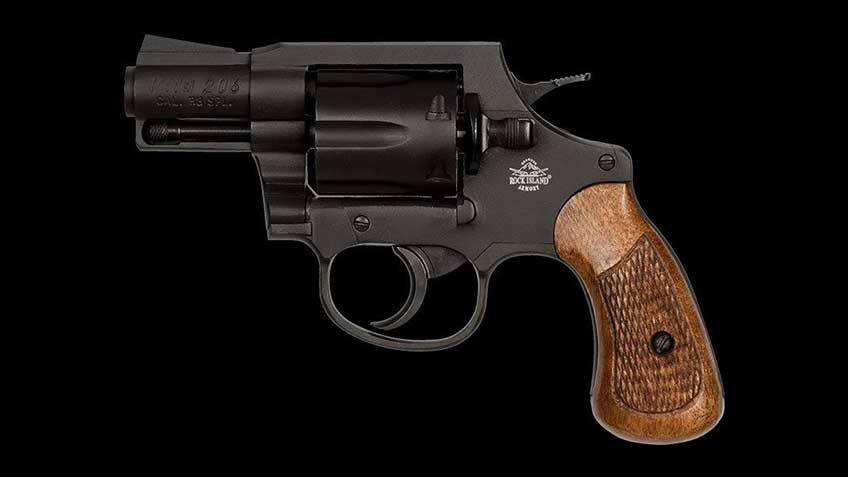
When a factory-fresh M206 revolver headed my fashion subsequently, I put it through the same bench checks used at the trade show. It demonstrated the same shine operation throughout the activity and in the trigger. The trigger required x lbs. 10 ozs. of trigger pull to cycle in double-action mode and 6 lbs. ii ozs. of pressure when fired single-activeness.
Included in the shipment was a good supply of Armscor Us .38 Spl. to break in the gun along with i of the total-size difficult black polymer grips usually installed on the 4" barrel M200. I was glad to have the grip, because I institute that the long hammer could compression the web of the shooting hand pollex when the hammer was cocked for single-action burn with the compact wood grip. Installing the polymer grip resolved the problem.
One of the first questions to popular upwardly with modern .38 Spl. revolvers is whether or not they tin safely fire +P armament. If a .38 Spl. cartridge loaded to SAMMI standard +P levels, it's going to generate somewhere around ix pct more pressure level than a standard load.
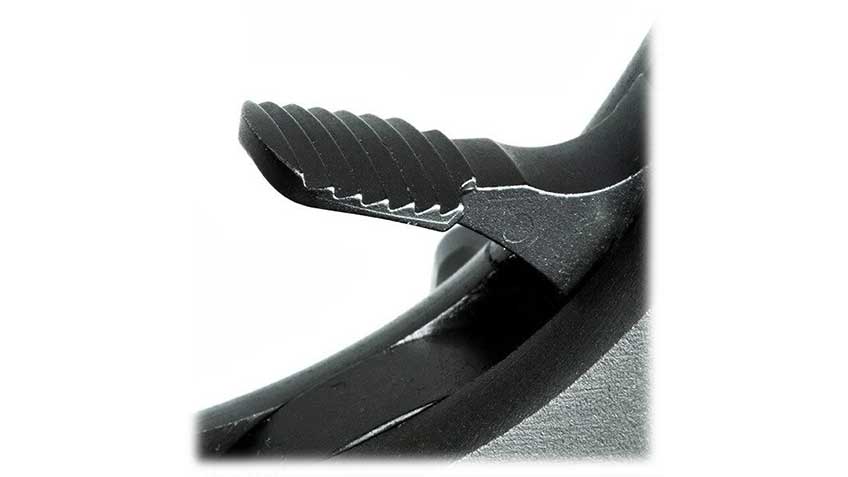
This may not sound like much of an increase but the heave in power causes revolvers to article of clothing out more than quickly and, in some cases with weaker or older guns, using +P loads could possibly cause a catastrophic failure.
When I asked the Rock Island representative at the merchandise bear witness if the M206 is rated for +P armament, he said I could go ahead and shoot information technology. Readers have reported that when they contact Stone Island they get the aforementioned answer.
However, if you look at the M206 barrel markings, the possessor's manual, and the company website, the gun is referred to equally existence a ".38 Spl." with no mention of +P ammunition. On folio five of the possessor's transmission it reads, "The M200 REVOLVER is chambered for Cal. .38 Special cartridges manufactured in accordance with standard industry practice." It could be argued that this argument includes SAMMI specification +P loads, just it's not very specific.
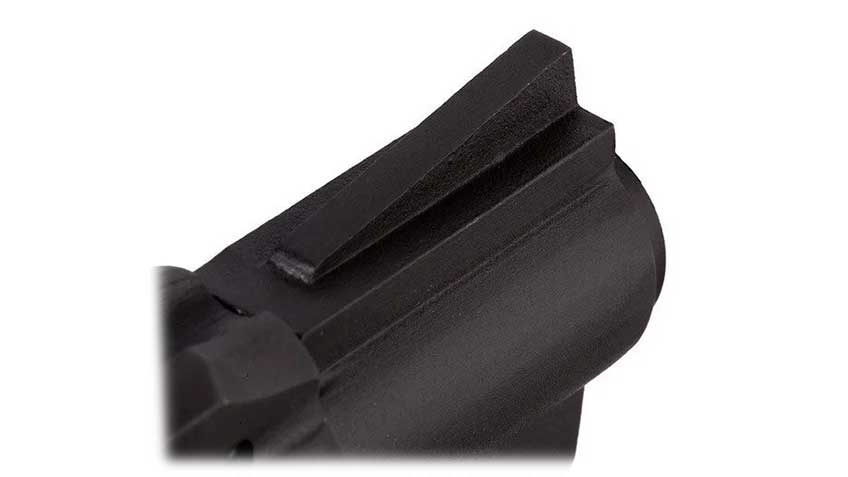
Other revolver manufacturer'southward who rate their revolvers every bit +P, including Ruger, Smith & Wesson and Charter Arms, come correct out and say information technology by writing ".38 Spl. +P" in their product descriptions and barrel markings. So when it came time to test the M206, I opted to work with standard pressure loads.
At the shooting range, the M206 six-shot was an enjoyable reminder of why mid-sized .38 Spl. revolvers were pop with police-enforcement personnel earlier the mass migration to semi-automatics. The 25-oz. weight of this snub gun is a bit heavy for concealed carry, but it tames the recoil of standard velocity .38 Spl. ammunition nicely.
All of the test ammunition loaded, fired and ejected reliably. Spent cases oft fell free from the cylinder without any help from the ejector. Shooting free manus at fifteen yards, it was not much of a challenge to maintain regular middle-of-mass shot placement. Formal accurateness testing was conducted from a bench remainder using the revolver in single-action mode firing into targets set at vii yards.
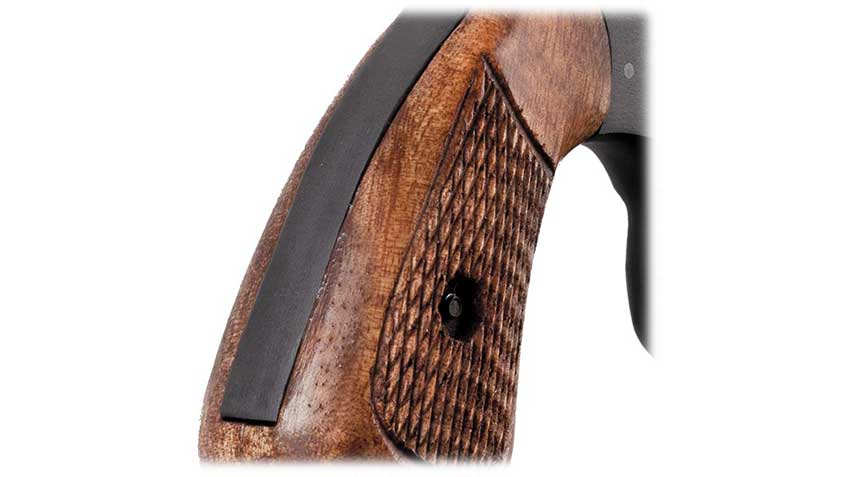
The results were on par with other 2" revolvers I've tested. HPR HyperClean 158-gr. jacketed hollow points produced the best single group of 1.85" with the all-time 5-group average of ii.04". Remington 110-gr. HTP semi-jacketed hollow points yielded an average of 2.17", followed by the Armscor 158-gr. full-metal jacket load at ii.19".
The M206 .38 Spl. is something of a shooting market contradiction. With the Parkerized models marked at a suggested retail price of $283, and real-world prices under $250, it seems like these 6-shot steel revolvers would have mediocre triggers and deportment. But much of the finishing work is done the erstwhile fashioned way: past manus.
The result in a polish action and trigger that is better than the revolver's cost would imply. If you are looking for a .38 Spl. that is affordable, enjoyable to shoot and shipped with a Limited Lifetime Warranty, this Rock Isle revolver deserves a closer look.
Stone Isle Armory M206 Specifications
Manufacturer: Rock Island Armory
Model: M206 Action: Double-Action Revolver
Quotient: .38 Spl.
Finish: Matte Black Parkerized
Grips: Meaty Checkered Hardwood
Sights: Fixed Cylinder
Width: one.40"
Barrel Length: 2.15"
Overall Length: 7.75"
Weight: 25 ozs. unloaded
Capacity: 6 rounds
Twist: 1:18" RH
Rifle Grooves: Six
Accessories: Hard Case, Owner'due south Transmission
MSRP: Parkerized $283, Nickel: $492
from: https://world wide web.americanrifleman.org/conten ... -revolver/
So, how does a Philippine company make a revolver then cheaply, when revolvers are famous (notorious?) for the amount of paw-plumbing fixtures required? The commodity just brushes this subject, but I wanted to delve into the matter farther. Ane of the well-nigh available sources of information on how guns work is the gunpartscorp.com site, which is the Gun Parts Corporation, successor to the erstwhile Numrich company that has been in business concern for well over 100 years. They often provide a parts diagram for individual guns. (Hint: save this link, considering y'all can use it for many other guns, likewise!)
My comments will be based on this diagram:

which is available from the full page here: https://www.gunpartscorp.com/gun-manufa ... esbing-200
the American Rifleman article noted that the revolver was similar to a Filly, but had the features of other makes. Unfortunately, the author didn't compare the revolver straight in size, because that would have told us what holster might be used: eastward.yard., can ane use a Filly Detective Special holster, or an Official Police holster, or a holster meant for another gun?
But Armscor choosing a Filly blueprint over a Smith & Wesson makes the gun cheaper to produce, and a amend gun, as well. You can first tell that the gun is Colt-based because the sideplate is on the left side, rather than the right, and because the cylinder rotates clockwise, rather than counter-clockwise, like nigh other double activeness revolvers.
The clockwise rotation is important, considering the paw, the part that turns the cylinder, pushes the cylinder into the frame, rather than out of the frame, like counter-clockwise cylinder rotation does. This eliminates the need to anchor the cylinder at both front and back of the cylinder. You will notice that Smith & Wesson revolvers have a lock on the forepart of the butt, which requires additional machining and fitting. Turning the cylinder the correct manner in the first place eliminates needless manufacturing expense and complexity. Another reward is that, on snub nosed revolvers, the ejector rod tin exist made longer when a cylinder lock isn't on the stop of the barrel. This longer ejector rod ensures that fired cases are more than reliably ejected in the reloading cycle.
Some other advantage to the Filly design that is seen in the pictures is moving the cylinder bolt slot to the side of the chambers on the cylinder. This ways that, different Smith & Wesson, the slots are not cut in the thinnest, weakest part of the cylinder, but rather to the side, in the thicker web portions.
The butt is pinned to the frame, like a Smith & Wesson. You tin can see this above the butt, where information technology threads into the frame. Colts don't have this pin, and I suspect the use of it allows Armscor to seat the barrels in a cheaper process, saving some more money.
A big savings is involved in the choice of lockwork, visible in the parts diagram. I would describe this lock equally the Ruger double activeness design, adopted to the Colt clockwise rotation with a sideplate on the left. (Rugers don't employ a sideplate.)
Colt, since 1905, and Smith & Wesson, after Globe War 2, each used a lock design that included a positive method of preventing an accidental discharge. This can happen if a revolver is dropped that doesn't have such a feature, such equally an IOF revolver. This safety feature allows a "6-shooter" to be a true six shot gun, rather than having to leave an empty chamber under the hammer, as with an IOF, and eliminates the need for a so-called" safety (that doesn't make anything safety!) equally seen on the IOF revolver.
The Ruger design eliminates the rebound lever of the Colt and the sliding bar of the Smith & Wesson and uses a transfer bar instead. You can see this transfer bar, #45, in the parts picture. This bar raises when the trigger is pulled. The hammer then strikes it and in turn, the transfer bar strikes the firing pivot. Thus, unless the trigger is pulled all the way dorsum, the hammer cannot hit the firing pivot and discharge the gun.
This design eliminates a lot of parts that crave close fitting in the Filly or Smith & Wesson designs, so a lot of coin is saved in manufacturing costs here, equally well.
The magazine commodity contains a picture of the hammer: look closely and you will see that it is most likely an injection moulded sintered steel part. Near likely, the internal parts of the revolver are fabricated past the same process. This allows parts to be made with minimal machining and finishing, because they are moulded to size or well-nigh to size, rather than needing to be machined from a block of steel to fit and work.
What I see hither is a gun that is intelligently designed, borrowing from what has worked in the past and marrying different systems together to provide a reliable weapon. Thus, it'southward not simply a cheap piece of junk or a slavish copy of an older blueprint. The idea that went into these revolvers gives the best of both worlds: an cheap gun that is too strong and reliable, and can be fully loaded to its full six shot capacity. I recall that a lot of people who are on a upkeep, yet want or demand to carry, would appreciate such a gun.
Consider the price: 0.2 lakh rather than ane.ii lakh. The reasons for this, I volition permit you, the reader, make full in for yourselves. I think it is a existent shame that such a weapon is not made in India. It wouldn't fifty-fifty need to bear the cost of aircraft it across the ocean to import information technology into another country! Unfortunately, information technology is unobtainable.
Anyway, I wanted to provide this as food for thought.
"Yous should tell someone what you know. There should be a history, so that men can learn from it." He smiled. "Men do non learn from history. Each generation believes itself brighter than the last, each believes it can survive the mistakes of the older ones. Each discovers each old thing and they throw upwards their hands and say 'See! Look what I take found! Wait upon what I know!' And each believes it is something new." Louis Fifty'Flirtation - "The Californios"
Source: https://indiansforguns.com/viewtopic.php?t=28517
Post a Comment for "Rock Island Armory M206 Parkerized Finish or Matte Nickel Review"